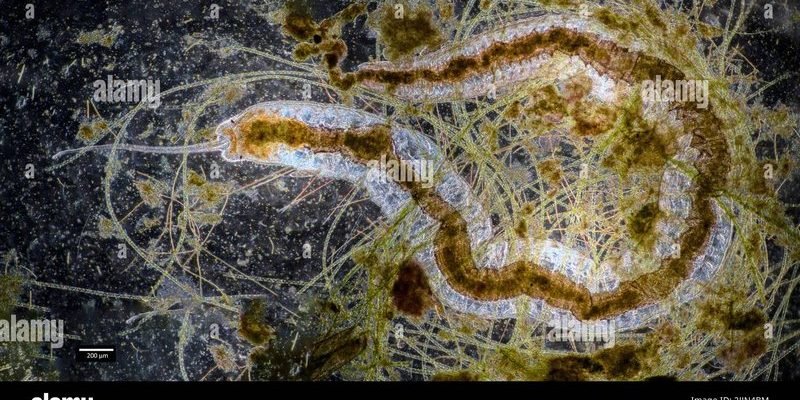
Bristle worms are more than just a squirmy presence in our oceans and soils. They play a crucial role in **nutrient cycling**, which is the process of recycling nutrients in various forms throughout the ecosystem. Think of them as nature’s recyclers—they break down organic matter, making nutrients available to plants and other organisms. Let me explain why these worms are the unsung heroes of the environment.
What Are Bristle Worms?
Bristle worms, scientifically known as **Polychaeta**, are a class of segmented worms that live in marine, freshwater, and even terrestrial environments. They have a long, cylindrical shape and are often covered with bristles or setae that help them move and grip surfaces.
You might encounter them in soft sediments or coral reefs, where they scuttle about, busy with their daily activities. Some species are small, just a few millimeters long, while others can grow to more than a meter! Imagine finding a long noodle in your garden or along the ocean floor—strange, right? But these creatures are essential for maintaining the balance in their habitats.
Just like tiny bulldozers, bristle worms help aerate the soil and sediment. As they burrow and tunnel, they improve the structure of the environment, allowing water and nutrients to circulate more freely. This is vital for the health of both plant life and other organisms.
The Process of Nutrient Cycling
Nutrient cycling is like a natural relay race where nutrients are passed around among various organisms. In this cycle, the same nutrients—like carbon, nitrogen, and phosphorus—are reused and recycled in different forms. Here’s how it generally works:
1. **Decomposition**: When plants and animals die, they decompose. This process is crucial because it breaks down organic matter into simpler compounds.
2. **Absorption**: As the organic matter decomposes, nutrients are released into the soil or water, becoming available for other organisms to absorb.
3. **Plant Uptake**: Plants take up these nutrients through their roots, using them to grow and thrive.
Bristle worms are key players in the first step of this cycle. As they feed on organic matter, they break it down more effectively than many larger organisms can. This not only speeds up decomposition but also ensures that more nutrients become available to plants and other marine life.
The Role of Bristle Worms in Soil Health
So, how do bristle worms contribute specifically to soil health? Well, their activities improve soil structure by creating channels for air and water to penetrate. This aeration is essential because healthy soil needs to breathe, just like we do!
If soil is compacted, it can lead to water logging and limit root growth for plants. Bristle worms help prevent this by:
- Mixing organic material: By consuming and excreting organic matter, they mix it into the soil. This enhances nutrient availability.
- Enhancing microbial activity: Their presence increases the diversity of microbes in the soil, which are essential for further breaking down organic material.
- Preventing erosion: Healthy soil structure helps to hold it together, reducing erosion from wind and water.
Imagine walking in a lush forest after a rainstorm. The earth feels soft and springy underfoot, right? That’s the result of countless organisms—like bristle worms—working tirelessly beneath the surface.
Bristle Worms and Marine Ecosystems
In marine environments, bristle worms contribute to nutrient cycling in several ways. They are a vital part of the food web, serving as prey for fish and other marine animals. This not only supports higher trophic levels but also ensures the continued cycling of nutrients through these ecosystems.
When bristle worms consume detritus (decomposing organic material), they break it down into smaller particles, improving its availability for smaller creatures, like zooplankton and benthic invertebrates. This process is essential for **marine nutrient cycling**, keeping populations thriving.
Here’s something cool: some bristle worms can even tolerate extreme environments, such as those found near hydrothermal vents. They feed on the nutrient-rich materials around these vents, demonstrating their adaptability and the breadth of their ecological role.
The Impact of Bristle Worms on Aquaculture
Bristle worms aren’t just important for natural ecosystems; they also play a significant role in aquaculture. In fish farming, maintaining water quality is key. Bristle worms help break down waste products and uneaten food, ensuring that the aquatic environment remains clean.
Healthy bristle worm populations can lead to:
- Improved water quality: Their activity keeps sediments healthy and prevents the build-up of harmful substances.
- Enhanced fish health: By contributing to a balanced ecosystem, they promote the overall health of farmed fish.
- Reduced feed costs: Bristle worms can help recycle nutrients, decreasing the need for additional feed in fish farming.
In essence, these worms help create a sustainable environment for aquaculture, making them invaluable to the industry.
Challenges Facing Bristle Worm Populations
Even though bristle worms play such a vital role in nutrient cycling, they face various challenges. Pollution, habitat destruction, and climate change can dramatically affect their populations and, subsequently, the ecosystems they support.
For instance, runoff from agriculture and urban areas can introduce harmful chemicals into their habitats, disrupting their life cycles. Additionally, rising water temperatures and ocean acidification threaten their survival.
Here’s the thing: when bristle worm populations decline, it can lead to a domino effect throughout the ecosystem. Fewer bristle worms mean less nutrient cycling, resulting in poorer soil quality and water health. This can ultimately jeopardize entire food webs.
Bristle worms might not be the first organisms that come to mind when thinking about nutrient cycling, but their role is essential. They are the unsung heroes that ensure our ecosystems remain vibrant and healthy.
From improving soil structure to supporting marine life, these tiny worms make a big impact. By understanding their role in nutrient cycling, we can better appreciate the interconnectedness of life on Earth. So next time you see a worm wiggling in the dirt or sand, remember that it’s not just a slimy critter—it’s a vital part of our planet’s health!

